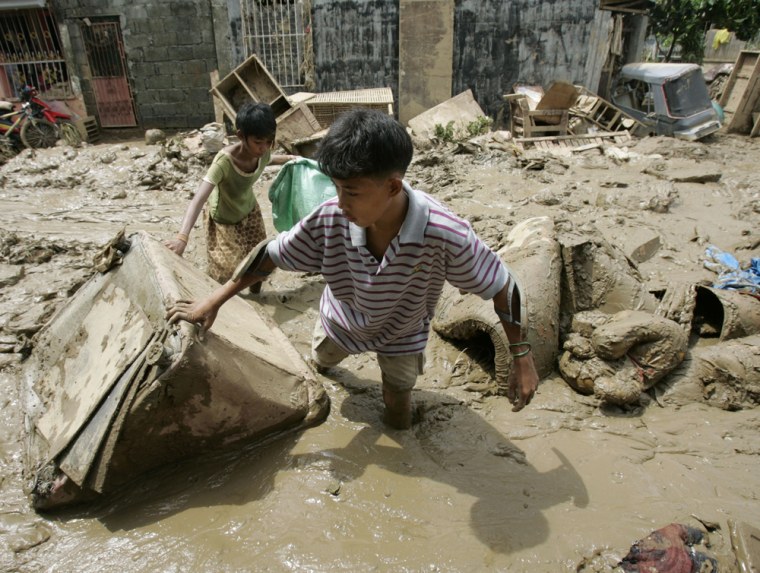The Philippines began evacuating a province near Manila on Thursday ahead of a looming typhoon, as rain falling on the saturated capital added to the misery of victims of recent floods and stoked fears of another disaster.
The sky has been clear over the sprawling metropolis for the past few days, allowing the more than 2 million people whose homes were inundated to begin scraping off the mud and muck left behind by Typhoon Ketsana.
That storm cut a destructive path across four Southeast Asian countries and killed at least 386 people — 280 in the Philippines, 92 in Vietnam and 14 in Cambodia. Laos was also hit, but no deaths were reported.
"We've been hit so hard. The situation now is just so difficult, and I don't know if we can take another calamity," said Glen Juban, whose 4-year-old daughter was swept away by floodwaters and drowned in Saturday's deluge.
Typhoon Parma edging closer
The steady drizzle that fell on Manila for a couple of hours Thursday came as Typhoon Parma — a storm forecasters said is already more powerful than Ketsana — edged closer to the eastern coast.
It could hit on Saturday, with sustained winds of up to 120 mph and gusts up to 140 mph, the government's weather bureau said.
"We are dealing with a very strong typhoon (and) there is a big possibility that this typhoon will gather more strength," said Nathaniel Cruz, PAGASA's chief weather forecaster. "Let us all pray."
The storm came as the region struggled to recover from two major earthquakes. The death toll from Tuesday's quake-triggered tsunami in the South Pacific rose to more than 150, while the toll from a powerful quake in Indonesia was more than 500 and climbing.
Philippine National Disaster Coordinating Council chief Gilbert Teodoro said evacuations had begun in one province north of Manila, and officials were poised to relocate other communities in Parma's path, once that became clearer on Friday. Refugees from Ketsana were asked to halt any plans to return home and stay in shelters.
President Gloria Macapagal Arroyo urged people to stay calm and follow local authorities' instructions.
"I hope the typhoon will hit another place," said Juban, whose family tried to escape from Ketsana-churned floodwaters by climbing onto the roof of their shanty house north of Manila, but who were washed away. He, his wife and 13-year-old son survived; his daughter did not.
Relief operations
Late Thursday, Parma was 270 miles off the Philippines' coast — close enough to bring rain to eastern districts — and heading northwest.
Meanwhile, relief and cleanup operations were under way in Vietnam, Cambodia and Laos.
In Vietnam, packets of instant noodles and bottles of water were delivered by helicopter or speed boat to villages still cut off two days after the storm.
In Cambodia, rain poured down Thursday on towns in Siem Reap province, adding to floodwaters three feet (a meter) deep. Schools, markets and other businesses were closed, deputy police chief Kan Sambath said.
Siem Reap is home to the country's famous Angkor Wat temple complex, and a Cambodian official said that, after three days of rain, if water levels in nearby rivers keep rising, floods could undermine the temples.
Roads, bridges and telecommunications were damaged in Laos along with homes and rice fields, the Laotian state news agency KPL reported.
Typhoons occur year-round in the northeastern Pacific, usually blowing in from the east and tracking a path threatening Southeast Asia and southern China to Japan in the north. They are most common and usually most powerful from August to November.
Ketsana followed on the heels of Typhoon Morakot, which slammed into Taiwan in early August, causing mudslides and the worst flooding on the island in 50 years. Morakot also killed 22 people in the Philippines and eight in China.
